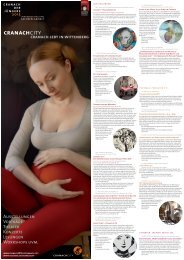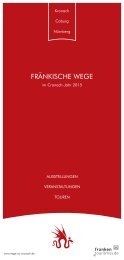In the Footsteps of Cranach - A Journey of Discovery
Twelve German towns and cities have come together in the 'Routes to Cranach' project to bring the life and works of the renowned Renaissance artist Lucas Cranach to the widest audience.
Twelve German towns and cities have come together in the 'Routes to Cranach' project to bring the life and works of the renowned Renaissance artist Lucas Cranach to the widest audience.
You also want an ePaper? Increase the reach of your titles
YUMPU automatically turns print PDFs into web optimized ePapers that Google loves.
11<br />
The visual language <strong>of</strong> <strong>the</strong> new faith –<br />
<strong>the</strong> first Reformation altar by Lucas <strong>Cranach</strong><br />
Schneeberg<br />
The Church <strong>of</strong> St Wolfgang is one <strong>of</strong> <strong>the</strong> large, light<br />
late-Gothic churches <strong>of</strong> Saxony and owes its existence to<br />
<strong>the</strong> rich reserves <strong>of</strong> silver in <strong>the</strong> Erzgebirge mountains during<br />
<strong>the</strong> 15th and 16th centuries. The church was almost<br />
completely destroyed during a bombing raid on 19 April<br />
1945. The only artworks that could be saved were eleven <strong>of</strong><br />
<strong>the</strong> twelve panels <strong>of</strong> <strong>the</strong> <strong>Cranach</strong> altar, and <strong>the</strong>se can be<br />
seen toge<strong>the</strong>r on <strong>the</strong> winged altar today. Work was carried<br />
out on <strong>the</strong> church until 1996 to restore it to its former glory.<br />
The Reformation altar in Schneeberg is one <strong>of</strong> <strong>the</strong><br />
most extensive works <strong>of</strong> <strong>the</strong> <strong>Cranach</strong> family. It was commissioned<br />
in 1532 and crafted by Lucas <strong>Cranach</strong> <strong>the</strong> Elder<br />
and his workshop until 1539. The altar has a series <strong>of</strong> images<br />
that places <strong>the</strong> most important stories <strong>of</strong> <strong>the</strong> Bible in a<br />
<strong>the</strong>ological context.<br />
The side <strong>of</strong> <strong>the</strong> altar on display on ‘work days’<br />
shows <strong>the</strong> well-known Law and Gospel, which <strong>Cranach</strong><br />
painted in different variations. Our gaze is drawn to Christ,<br />
through whom man is granted salvation – this was <strong>the</strong><br />
central belief <strong>of</strong> <strong>the</strong> reformers’ <strong>the</strong>ology. Man is “justified”<br />
(“just”) by God through Christ’s redemption and enters<br />
into a new, liberated relationship with God, one’s fellow<br />
men and oneself. <strong>In</strong> terms <strong>of</strong> iconography, this notion is<br />
visualised by <strong>the</strong> figure <strong>of</strong> Adam standing upright under<br />
<strong>the</strong> cross.<br />
The ‘feast day’ side <strong>of</strong> <strong>the</strong> altar is characterised by<br />
<strong>the</strong> powerful image <strong>of</strong> Christ’s crucifixion in <strong>the</strong> centre.<br />
It is flanked with panels showing Elector Johann Friedrich<br />
<strong>of</strong> Saxony and Duke Johann Ernst <strong>of</strong> Coburg. The altar<br />
predella, which is always visible, shows a depiction <strong>of</strong> <strong>the</strong><br />
Last Supper.







